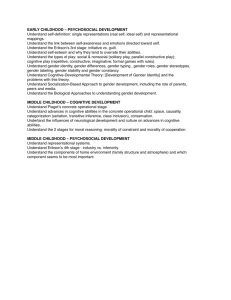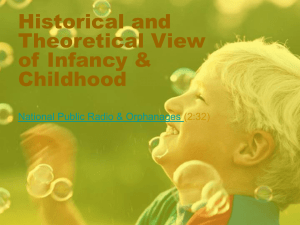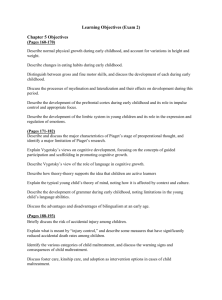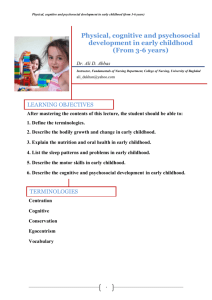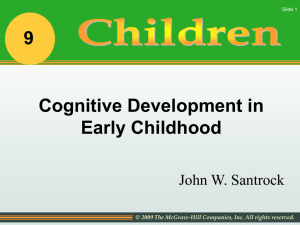Ross A. Thompson, Ph.D. Department of Psychology University of
advertisement
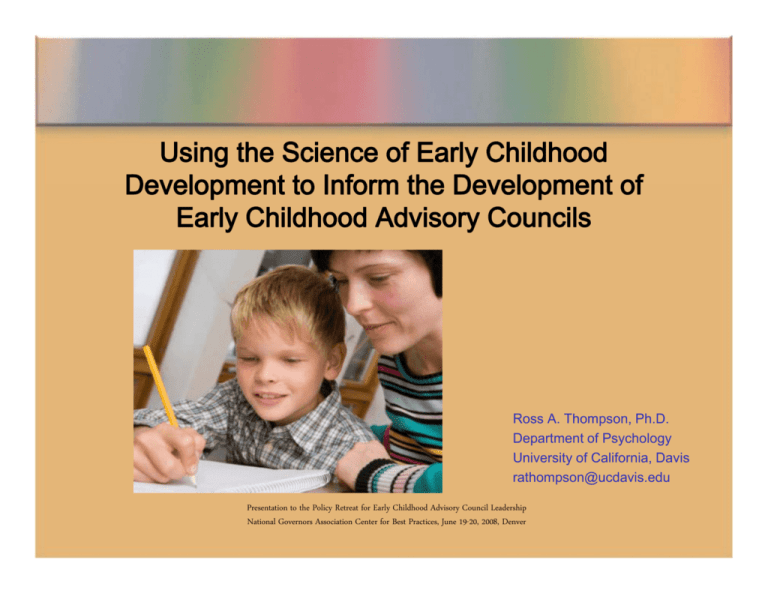
Ross A. Thompson, Ph.D. Department of Psychology University of California, Davis p @ rathompson@ucdavis.edu Presentation to the Policy Retreat for Early Childhood Advisory Council Leadership National Governors Association Center for Best Practices, June 19-20, 2008, Denver Neuroscience, developmental psychology, molecular biology, and the economics of human capital formation are y yielding g a common focus on development in the early years Brain Growth in the Early Months newborn 1 month 3 months 6 months Brain Growth in the Years that Follow Human Brain Development Synapse Formation Dependent on Early Experiences Language Sensory Pathways (Vision Hearing) (Vision, Higher Cognitive Function FIRST YEAR -8 -7 -6 -5 -4 -3 -2 -1 1 2 3 4 5 6 7 8 9 10 11 1 2 3 4 5 6 7 8 9 10 11 12 13 14 15 16 17 18 19 Birth (Months) (Years) Source: C. Nelson (2000) Supportive relationships are the “active ingredients” of healthy development Cognitive, social, and d emotional ti l development d l t are deeply interdependent in the early l years Emotional health and social competence are a strong foundation for emerging cognitive abilities Early y childhood stress influences developing p g brain architecture Chronic, severe, and/or uncontrollable stressful experiences and can lead to stress management systems that respond at lower thresholds, thresholds and may impair learning and memory Risk Factors for Adult Depression are Embedded in Adverse Childhood Experiences Odds s Ratio o 5 4 3 2 1 0 1 2 3 # Adverse Childhood Experiences 4 5+ Source: Chapman et al, 2004 Persistent Stress Changes Brain Architecture Normal Normal Chronic stress Prefrontal Cortex and Hippocampus Chronic stress Amygdala Source: C. Nelson (2008) How Ho Should Sho ld We Act On the Science? “The early childhood years lay a foundation that influences the effectiveness of subsequent education efforts. efforts.” “Early “E l intervention programs can improve the odds for vulnerable young y g children” From Neurons to Neighborhoods: The Science of Early Childhood Development (www.nap.edu) The Mismatch Between Opportunity and Investment Brain's "Malleability" Spending on Health, Education and Welfare Age 0 3 10 70 Implications from Developmental Science • It is better to prevent problems from developing than to remediate them later • Pay attention to all aspects of early growth: physical health, cognitive, social, emotional • Provide opportunities for healthy growth that are developmentally and brain-appropriate developmentallybrain appropriate • Incorporate close relationships into efforts to improve children’s children s outcomes (two generations) • Start early, and invest with long-term yields in mind Science Points Toward a 3-Tiered Approach to Ensuring Healthy Development 3: Narrowly targeted targeted, specialized services for children experiencing toxic stress to prevent later problems 2: Broadly targeted interventions for children in poverty (e.g., income supports and early enrichment) to give i all ll th the chance h to t succeed d TIER 3: NARROWLY TARGETED TIER 2: BROADLY TARGETED TIER 1: UNIVERSALLY AVAILABLE 1: Basic health services and early care and education available to all children to help build and sustain strong brains and bodies www.developingchild.harvard.edu www.developingchild.net



